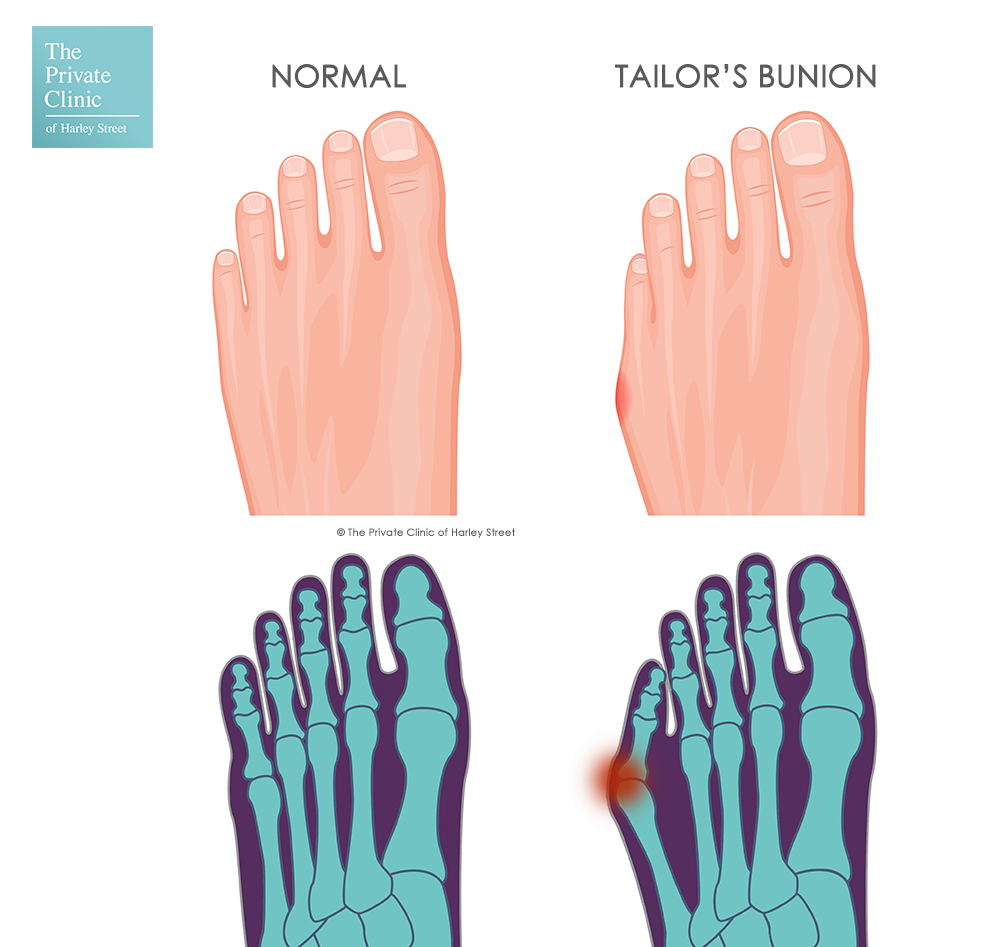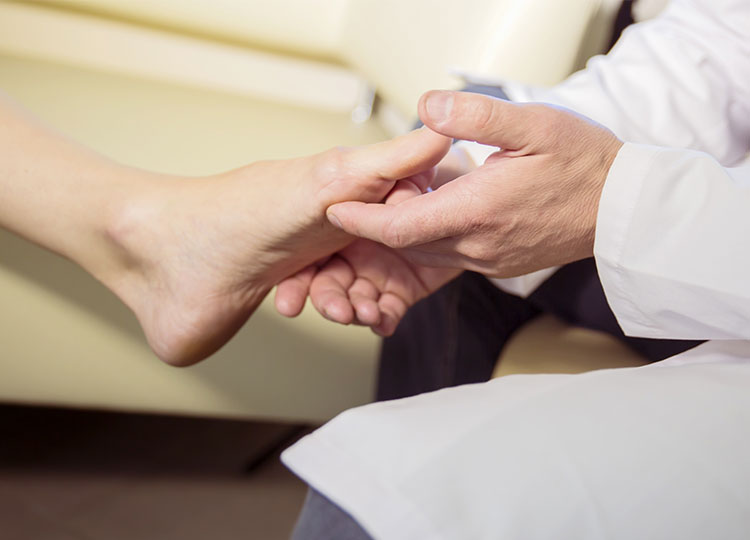
Tailor’s Bunion Surgery
Minimally invasive tailor’s bunionette deformity correction surgery with no metal fixtures is exclusive to The Private Clinic.
What is a tailor’s bunion?
A tailor’s bunion is a bunion that forms on the side of little toe. Also referred to as a bunionette – they occur when the bone at the bottom of the little toe, the fifth metatarsal, enlarges or moves outwards.
What causes a tailor’s bunion?
Tailor’s bunions get their name from the link to how tailors use to sit in the 1950’s while working, in a cross legged position causing pressure. Although this may be a valid cause, you would have to sit crossed leg for quite some time to have a tailor’s bunion form this way.
Uncomfortable or tight, ill-fitting shoes have also been noted as a cause for tailor’s bunions, but many patients find that their tailor’s bunion is caused by an inherited structural defect within their foot.


Tailor’s Bunion Symptoms
Tailor’s bunions are very similar to regular bunions, but they are just in a different location on the foot, both being caused by a defect in the small bones in the toes.
If you have a tailor’s bunion you will most likely be able to diagnose it upon viewing a visible lump on the side of the little toe. Other symptoms include:
- Shoes rubbing.
- Swelling of the little toe.
- Redness in the affected area.
- Pain in the affected area.
The Private Clinic have collaborated with Chrysalis Finance to offer 0% finance for our patients.*
*Acceptance is subject to status. Terms and conditions apply.
Tailor’s Bunion Treatment
Consultations with Mr Andrea Bianchi are available at our clinic in London Harley Street and Bournemouth.
Consultations with our patient co-ordinators are available in Birmingham and Northampton. This is a great way to find out more about the procedure and what is involved before meeting with our Consultant Orthopaedic Surgeon in London.
What are the advantages of the tailor’s bunion surgery technique?
- Our bunion removal procedure is exclusive to The Private Clinic Group.
- We perform over 1,200 procedures each year with a success rate of 98%
- No screws, plates, wires, or metal fixtures are used in surgery.
- Keyhole surgery is used which means no big scars.
- Minimal downtime with no need for crutches.
- No overnight stay is required.
- Premium aftercare support.
- Our bunion treatment has been featured in Tatler’s, Harper’s Bazaar, Marie Claire, Net Doctor and The Daily Telegraph.
The Tailor’s Bunion Procedure
Our Tailor’s bunion procedure is a minimally invasive keyhole surgery procedure performed at our hospital in central London.
You will have a local anaesthetic injected into the area being treated so that you will remain pain-free throughout the procedure.
The keyhole procedure is performed under precision using continuous X-ray imaging known as a fluoroscopy. Mr Bianchi makes a very small 2-3mm incision to enable him to modify the bones in the little toe and correct the deformity using surgical dental burrs.
When the bones have been realigned, the geometric fractures are left free to heal without the use of any screws, pins or other fixative devices. This allows the foot to heal in a natural position in alignment with the patient’s load-bearing needs and not to a pre-set standard. This method of healing reduces discomfort and increases foot functionality post-procedure.
You will be required to wear a specialised orthopaedic shoe for the first 20 days and the foot will be bandaged and taped using a specialised bandaging technique which promotes a physiological healing process to restructure the foot and reduce additional stress which is usually caused by arbitrary immobilisation. Before you leave the hospital, you will be encouraged to walk on your foot without the use of crutches.
Tailor’s Bunion Surgery Downtime
The downtime following tailor’s bunion procedure is minimal in comparison to other more extensive procedures that require a long period of rest and time off work.
Patients will be able to walk without the use of crutches almost immediately post-surgery and many return to work and their everyday activities after 1-2 days. We do suggest that you rest the foot where possible and avoid standing for long periods but equally too long spent sitting can also cause swelling so best to keep mobile.
An orthopaedic boot must be worn until you return for your follow-up appointment 15-20 days post-treatment and during this time your bandage must not get wet.
Tailor’s Bunion Surgery Recovery
Your post-op appointment will happen around 25 days following your procedure. During this appointment, your bandages will be reduced, and you will most likely be able to go back to wearing comfortable wide-sole shoes and a surgical sock for another 10-15 days to continue the rest of your recovery.
At 45 days post procedure a follow-up x-ray will be arranged for your surgeon to assess the results of your procedure in more detail.
Tailor’s Bunion FAQs
Yes, we offer a minimally invasive surgical procedure that can correct tailor’s bunions.
The procedure is performed via small 2-3mm keyhole incisions and no fixative devices are used meaning your recovery should be quick and pain free. All patients are able to walk on their foot before leaving the hospital.
There are many non-surgical methods that claim to treat a Tailor’s bunion however these are not effective in all cases and if you are looking for guaranteed results then surgery is the only option.
How do you shrink Tailor’s bunions naturally?
Non-surgical methods to help reduce a tailor’s bunion include:
Avoid wearing narrow or pointed shoes and high heels. Regular cold compress to the foot throughout the day Applying a bunion pad to avoid shoes rubbing. Regular calf stretches throughout the day. Non-steroidal anti-inflammatory medication such as Ibuprofen Steroid injections
Non-surgical and natural methods are unlikely to resolve a tailor’s bunion, but they can help with any discomfort and pain associated with the bunion and help to prevent it from getting worse.
How do you fix a Bunionette?
The best method of treatment to fix a bunionette or tailor’s bunion is surgery. Our minimally invasive procedure is a great option for those who do not want the downtime and lengthy recovery period associated with traditional bunion surgery.
Our exclusive procedure is performed using a keyhole surgery technique. The surgeon will make a 2-3mm incision and use a dental burr to make small, precise fractures into the toe bone. This allows the surgeon to realign the bones and correct the positioning of the toe. This will remove the physical appearance of the tailor’s bunion and relieve any pain that may have been felt previously.
No fixing devices like pins and plates are used in our unique surgical procedure and instead the bones are left to heal naturally. This allows the foot to heal according to the patient’s load-bearing needs and not to a pre-set standard that may not be right for the patient which can cause discomfort and difficulty walking post-procedure.
Patients are able to walk post-procedure without the need for crutches and many can return to work within 1-2 days. An orthopaedic support boot will need to be worn for around 20 days post procedure to help support the foot whilst it heals but after this time frame you should be able to wear comfortable shoes such as wide fit trainers.
Do I have a tailor’s bunion?
You will most likely be able to see if you have a bunionette or tailor’s bunion from looking at your foot. A bunionette will appear as a visible bump on the side of your foot at the base of your little toe. Your little toe may also appear to be turning inwards and it may look red and swollen. Some people experience pain, especially when wearing shoes or after wearing shoes all day but pain is not always a symptom.
If you are unsure if you have a bunionette or tailor’s bunion, book a consultation where our expert surgeon will be able to examine you and suggest the best treatment options.
Initially a tailor’s bunion may hardly be noticeable, but you may start to notice a change in the position of your little toe. Your toe will begin to lean towards the other toes and a small bump which will feel hard and lumpy will appear at the base of your toe on the edge of your foot.
The development of a tailor’s bunion is very slow and gradual so it may take a number of years before you even notice it. As time goes on, the symptoms may begin to be more noticeable with pain, swelling and general discomfort being felt. Tailor’s bunion symptoms often feel worse after wearing tight shoes, high heels or after standing or walking for long periods of time.
A tailor’s bunion or bunionette is rare but it is a lot more common in people who have:
- A structural problem with their feet Suffer from poor foot function.
- Loose ligaments.
- Feet that naturally lean on the outer edges
- Wearing tight shoes and high heels can also attribute to the formation of a tailor’s bunion.
Our minimally invasive bunionette surgery is performed under local anaesthetic so patients should not feel any pain throughout the procedure and our expert medical team will ensure that you are feeling comfortable at all times.
You may feel some discomfort and pain following surgery once the local anaesthetic has worn off, but this should be easily managed with painkillers.
A consultation with our expert Orthopaedic surgeon, Mr Andrea Bianchi is £200 which includes a free x-ray of your feet which is carried out on-site.
Tailor’s bunion surgery starts is £5,780 for 1 foot which includes the cost of the post-operative shoe and x-ray. If you require surgery on your other foot, this will be charged at £4,250.
Book your consultation today to find out how our keyhole bunion surgery is performed and how it is different from other bunion operations.
Our prices include a full treatment solution and minimally invasive procedure with no insertion of screws, wires, or metal pins. Patients are able to walk immediately after the procedure with no need for crutches or physiotherapy. Recovery time is greatly reduced with many returning to work within 1-2 days and back exercising within a month.
Book a consultation
Begin your Tailor’s Bunion treatment pathway by booking a consultation with our expert Consultant Orthopaedic Surgeon.
Get in touch
If you have any questions about the bunion treatment process, drop us a message using our online enquiry form.




